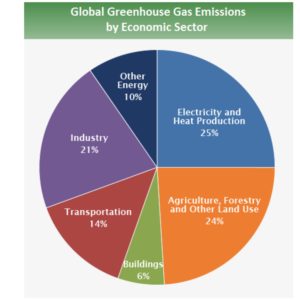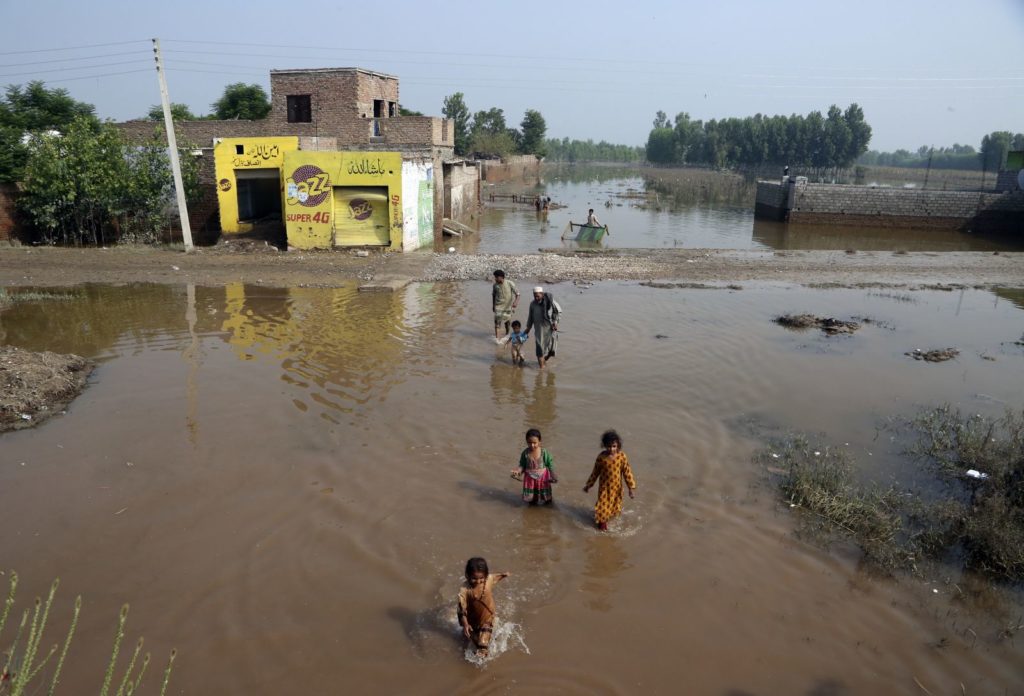
Daily flooding in Miami.
Nantucket is expected to be underwater in about 200 years.
Over 500,000 people were displaced by floods in Pakistan.
Temperatures of 115 degrees in Phoenix in July 2022.
Historic damage and loss of life from Hurricane Ian in September 2022.
Climate change is behind it all.
The devastation caused by climate change’s economic and physical impact is becoming more evident worldwide. The impact of these changes is prompting insurance companies, corporations, regulators, investors, and individual citizens to take action since they realize that changes in global temperatures are threats that can disrupt entire economies, flood inhabited areas, and make severe weather events more common.
Since the first Earth Day in 1970, environmentalists have sounded the alarm about the dangers of pollution, and the need for clean air and water. However, during those 50 years, policymakers did not enact any large projects that addressed the risks, mainly due to resistance from petrochemical companies, regulators, and investment firms. So, as scientists released more dire environmental news, the problem of climate change takes on a more immediate, severe, and economic meaning.
Today, the economic impact of climate change is real. A 2021 White House report found that the economic damages in the U.S. alone from storms, floods, droughts, and wildfires have reached over $100 billion annually. Related dangers from flooding, and the release of dangerous materials, including radiation, will create “tipping points” that “create systemic risk for economic systems globally.” These risks can cost corporations billions.
Florida Hurricane Highlights the Financial Losses
The financial cost of Hurricane Ian is the most recent example of the tremendous financial costs of natural disasters. While these costs are still being determined, its direct replacement costs of lost buildings and infrastructure in Florida alone could be at least $250 billion.
In the past year, six Florida insurance companies have gone bankrupt, as the population has increased. Insurance premiums can increase by up to 40% because the state of Florida has a hurricane tax that allows the state to tax homeowners to cover flood and home insurance costs.
Chuck Watson, a disaster modeler at Enki Research, said the storm could cost the U.S. up to $67 billion in economic damages. Besides damaging homes and infrastructure, the hurricane also ruined orange farms in the largest producing state, causing orange juice prices to surge, according to ClimateChangeNews
Only around 30% of the damage is covered by commercial insurance, Watson told Climate Home News. Due to its high cost and limited availability, about 60% of Florida residents do not have flood insurance, according to a 2020 McKinsey report. This means financial disaster for thousands of residents.
This will also be bad news for the expensive ocean-from luxury home market. Despite the expected soothing messages from the Florida luxury real estate industry, rising ocean levels and the threat of more violent hurricanes will not protect residents who buy expensive condos, with HOA fees of over $800 a month, overlooking a potentially violent beachfront.
Climate Change is the Cause
A 2020 MarshMcLennan paper reiterated this danger when it said, “climate change is one of the most—if not the most—pressing challenge of our times.”
This same paper said, “climate change will put around 2 percent of global financial assets at risk by the year 2100. A worst-case scenario could see up to 10 percent of global financial assets being at risk by 2100. Such is the scale of the devastation that we should be ready for – and we need to accelerate our preparation now.”
Worse, Republicans are now opposing any attempt to limit climate change by pension, mutual, and private funds by preventing investment companies from engaging in ESG investing.
Climate Change Can Bankrupt Corporations
This danger became evident in the historical bankruptcy of the California electric company, PG&E. This bankruptcy affected risk measures among credit issuers, market participants, utility customers, business operations, taxpayers, and the company’s reputation. In January 2019, PG&E sought bankruptcy protection after it was hit with an estimated $30 billion in liability for fires in drought-stricken areas related to faulty equipment. At the time, an insurance blog called this the world’s first “climate change bankruptcy.” 
The PG&E bankruptcy also alarmed other investment firms and corporations. The default focused attention on investments in mining, energy, manufacturing, and forestry industries dependent on climate change. The bankruptcy meant that corporations had a fiduciary duty to address climate-related situations which could jeopardize their investments.
It also puts pressure on financial market regulators that have a significant role in promoting the change to build a sustainable economy.
For instance, according to Isabel Munilla, Director, U.S. Financial Regulation for Ceres, a non-profit focused on sustainability efforts, the SEC and the Federal Reserve play a critical role in being able to address climate risk. These agencies can raise interest rates on petroleum loans or mandate that companies report on the environmental impact of their business operations.
The SEC has also put its weight behind the need for more climate-related disclosures from corporations. “It makes sense to build on what many corporations are already doing to enhance the consistency, comparability, and decision-usefulness of climate disclosures for investors,” SEC Chairman Gary Gensler said.
Climate Change Risk Endangers Businesses Worldwide
Among the primary concerns of professional investment management is identifying and managing risk. In traditional investment management, the risk is categorized as systemic and non-systemic. Some risks, such as war, interest rate changes, or recessions, affect the entire market (systemic), while others (non-systemic) affect specific industries or sector stock categories.
Today, the investment focus on sustainability turns on the $17 trillion in assets managed according to environmental, social, and governance (ESG) principles worldwide. ESG now covers how corporations manage their operations to minimize environmental risks from climate change, pollution, and carbon dependence as systemic risks that can endanger the operation of the global financial system.
climate change is one of the most—if not the most—pressing challenge of our times.
In addition, ESG investment principles address the treatment of employees, customers, local communities, workforce diversification, working conditions, and administrative transparency. But, again Republicans oppose ESG because it targets the petroleum industry and gives more power to investors.
According to CERES, the main types of systemic risk posed by climate change are more severe weather events worldwide, significant environmental changes, and technological risks associated with moving to a more environmentally-friendly economy. Making these needed changes will impact large and politically powerful financial institutions with major petrochemical industry investments.

For instance, the Center for American Progress said that the six largest banks made over $700 billion in loan commitments to the fossil fuel industry from 2018 to 2018. Large insurance companies hold $528 billion in polluting industry investment, according to a 2016 survey.
Today, there is a growing awareness worldwide that environmental risk can endanger the entire planet. As Munilla of the Ceres Accelerator for Capital Markets said, “Climate change is the ultimate risk.”
Climate Change: Environmental Dangers and Opportunities
The tipping point in industry awareness about the dangers of climate change can be pegged to two significant events. The first was the release in 2005 of a report from the United Nations Environment Programme, the Freshfields Bruckhaus Deringer report, which created a legal framework for the integration of ESG investing.
“When that report was released, Europe turned on a dime and started to say that pension funds needed to integrate these things. This spilled over to many U.S. firms, which realized that if they wanted European business, they would need to build their ESG capacity to

serve that audience,” according to Amy Domini, founder, and chair of Domini Impact Investments, a leading ESG investment firm.
The second event focused on climate change. The 21st Annual Conference of the Parties (COP 21), held in Paris in December 2015 and ratified in early October 2016 by 74 signatories, elevated “global warming toward the top of the financial services agenda,” according to a paper, “Climate Change: The Investment Perspective,” released by Ernst & Young, in the United Kingdom.
Today, ESG is a global initiative as some nations move away from relying on petrochemicals. It also presents new investment opportunities as innovative technologies replace traditional combustion power sources. “On the upside, research suggests that investment opportunities arising from the energy transition will outweigh climate-related risks in the long term,” the Ernst & Young report found.
As more investors realized this opportunity, “ESG became of legitimate interest in the late-1990s and early-2000s because people believed that ESG factors were material to the value of companies. They also saw that there were advantages to investing in the stocks of these companies,” Domini wrote in an email.
“The urgency of climate change has prompted over 1,200 companies to adopt net zero targets, reduce their emissions, and align their business to a low-carbon future. The SEC will mandate climate-related disclosures that will position all of us to better evaluate the exposure to climate-related risk and the level of ambition among companies to address it. We are also seeing that more global regulators are also acting. The pace and scale need to be accelerated, and we’ll keep calling on companies to do that,” Domini said.










